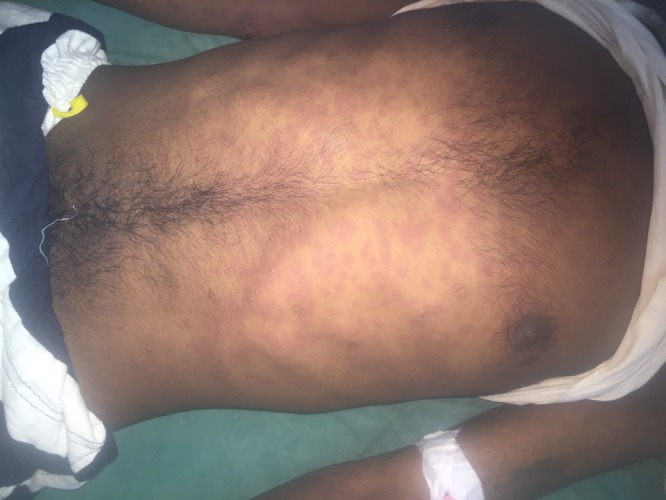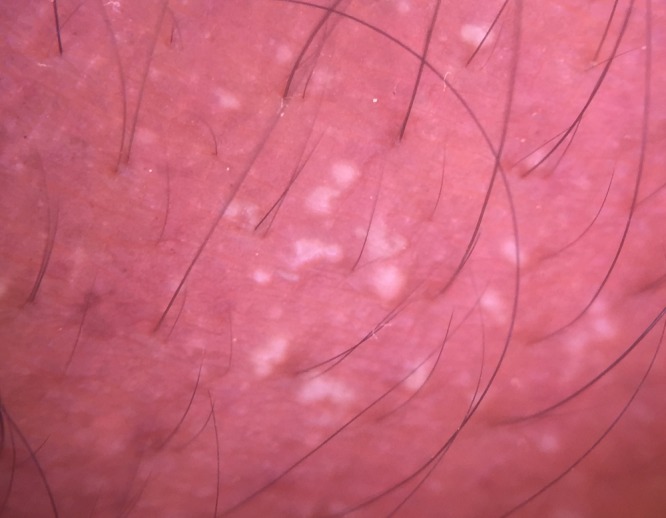Abstract
Acute generalized exanthematous pustulosis (AGEP) is a rare severe cutaneous adverse reaction caused mostly by medication. Early diagnosis is important as initiation of supportive treatment and avoidance of drug is of prime importance. A young male presented with an erythematous rash after taking diclofenac for pain. Polarized dermoscopy revealed milky globules on a uniform reddish background sparing the follicles, which confirmed the diagnosis of AGEP.
Keywords: dermoscopy, milky globules, acute generalized exanthematous pustulosis
Case Report
A 29-year-old male presented with a two-day history of rash after taking the nonsteroidal anti-inflammatory drug, diclofenac, for pain. On examination there were multiple erythematous macules all over the trunk (Figure 1). Polarized dermoscopy revealed milky globules on a uniform reddish background sparing the follicles (Figure 2). A diagnosis of acute generalised exanthematous pustulosis (AGEP) was made.
Figure 1.

Multiple erythematous macules all over the trunk. [Copyright: ©2017 Jha et al.]
Figure 2.

Dermoscopy (polarized 10X) showing milky globules on a uniform reddish background sparing the follicles. [Copyright: ©2017 Jha et al.]
Discussion
Acute generalized exanthematous pustulosis (AGEP) is a rare severe cutaneous reaction pattern that in the majority of cases is related to medication administration [1–3]. Early diagnosis of AGEP is of paramount importance, as it necessitates a more aggressive therapeutic approach because it carries a worse prognosis [4,5]. The cutaneous manifestations of AGEP are usually associated with fever and leukocytosis, mostly due to blood neutrophil count above 7000/mcL. Mild eosinophilia may be present in about one-third of the patients [3]. Internal organ involvement is relatively rare and the mortality rate is approximately 5% [6]. In this patient, AGEP mainly showed small, milky, roundish globules, histologically corresponding to nonfollicular subcorneal pustules, a pinkish-reddish background, consistent with dermal inflammation [7]. No distinct vascular structure was evident. Dermoscopy may help in diagnosis at an early stage, as awaiting histopathology reports may prolong the treatment.
Footnotes
Funding: None.
Competing interests: The authors have no conflicts of interest to disclose.
All authors have contributed significantly to this publication.
References
- 1.Sidoroff A, Halevy S, Bouwes Bavinck JN, Vaillant L, Roujeau JN. Acute generalized exanthematous pustulosis (AGEP)—A clinical reaction pattern. J Cutan Pathol. 2001;28:113–119. doi: 10.1034/j.1600-0560.2001.028003113.x. [DOI] [PubMed] [Google Scholar]
- 2.Cohen AD, Cagnano E, Halevy S. Acute generalized exanthematous pustulosis mimicking toxic epidermal necrolysis. Int J Dermatol. 2001;40:458–461. doi: 10.1046/j.1365-4362.2001.01241.x. [DOI] [PubMed] [Google Scholar]
- 3.Roujeau JC, Bioulac-Sage P, Bourseau C, et al. Acute generalized exanthematous pustulosis. Analysis of 63 cases. Arch Dermatol. 1991;127:1333–1338. [PubMed] [Google Scholar]
- 4.Vassallo C, Derlino F, Brazzelli V, D’Ospina RD, Borroni G. Acute generalized exanthematous pustulosis: report of five cases and systematic review of clinical and histopathological findings. G Ital Dermatol Venereol. 2014;149:281–290. [PubMed] [Google Scholar]
- 5.Rawlin M. Exanthems and drug reactions. Aust Fam Physician. 2011;40:486–489. [PubMed] [Google Scholar]
- 6.Roujeau JC. Clinical heterogeneity of drug hypersensitivity. Toxicology. 2005;209:123–129. doi: 10.1016/j.tox.2004.12.022. [DOI] [PubMed] [Google Scholar]
- 7.Errichetti E, Pegolo E, Stinco G. Dermoscopy as an auxiliary tool in the early differential diagnosis of acute generalized exanthematous pustulosis (AGEP) and exanthematous (morbilliform) drug eruption. J Am Acad Dermatol. 2016;74(2):e29–31. doi: 10.1016/j.jaad.2015.10.030. [DOI] [PubMed] [Google Scholar]


